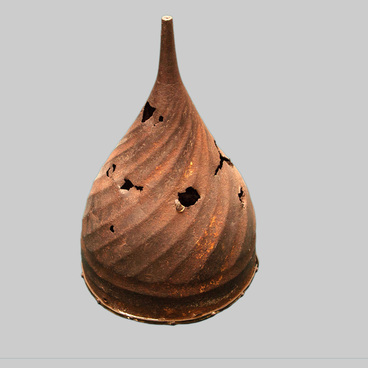Service people in Siberia extensively used protective weapons. During the whole of the 17th century, cossacks and streltsy, who practically did not use armour during the hostilities in the ‘west’, being behind the Urals, tried to hastily acquire shells and helmets. They felt vulnerable in battles against militant aborigines. The West Siberian peoples fought with bows and arrows with iron and bone warheads and used long-bladed weapons in horse attacks. So the iron ring shells were an irreplaceable defense.
Unlike European Russia, in Siberia, only military elite, but also ordinary fighters wore the defensive weapons.
Protective shells had two varieties, ringed, which were bonded from the rings, and plate-armour, in which the protective plates were either bonded to each other or put onto a leather or fabric base. In Siberia, the most common type of ringed shell was the chain mail. This is what the Tobolsk Museum Reserve displays.
The armour is cut out in the form of a shirt with short sleeves. It has a chest incision and underground, plus four incisions at the bottom. Researchers suggest that this was to make the shell elastic. It was also easier to wear armour with these incisions — if there was no incision, the warrior would probably not have been able to fit into them because the hem was too tight.
The shell is made of two types of rounded and flattened rings: riveted and welded rings. The craftsman used a single weaving — he inserted four adjacent into each ring. To produce one chain mail, the blacksmith pulled out a metal wire about 600 metres long. Then he sliced it into three-centimeter pieces and twisted them into rings. He welded half of them and flattened the edges of the rest of them and punctured holes in them. There were about 20,000 rings on one chain mail. It could weigh up to 17 kilograms. A chain mail was made wherever there was a high level of blacksmithing and enough iron.
Russian service people wore similar shells in the 16th and 17th centuries. Historians believe that it was made by Russian armourers, either Tatar or Central Asian craftsmen.
Unlike European Russia, in Siberia, only military elite, but also ordinary fighters wore the defensive weapons.
Protective shells had two varieties, ringed, which were bonded from the rings, and plate-armour, in which the protective plates were either bonded to each other or put onto a leather or fabric base. In Siberia, the most common type of ringed shell was the chain mail. This is what the Tobolsk Museum Reserve displays.
The armour is cut out in the form of a shirt with short sleeves. It has a chest incision and underground, plus four incisions at the bottom. Researchers suggest that this was to make the shell elastic. It was also easier to wear armour with these incisions — if there was no incision, the warrior would probably not have been able to fit into them because the hem was too tight.
The shell is made of two types of rounded and flattened rings: riveted and welded rings. The craftsman used a single weaving — he inserted four adjacent into each ring. To produce one chain mail, the blacksmith pulled out a metal wire about 600 metres long. Then he sliced it into three-centimeter pieces and twisted them into rings. He welded half of them and flattened the edges of the rest of them and punctured holes in them. There were about 20,000 rings on one chain mail. It could weigh up to 17 kilograms. A chain mail was made wherever there was a high level of blacksmithing and enough iron.
Russian service people wore similar shells in the 16th and 17th centuries. Historians believe that it was made by Russian armourers, either Tatar or Central Asian craftsmen.


